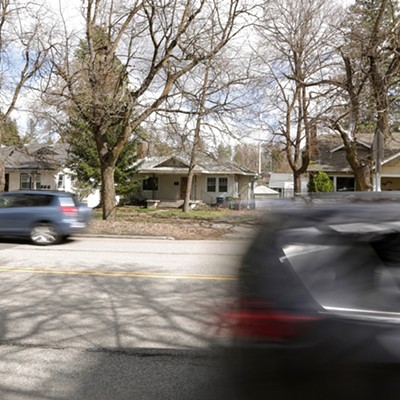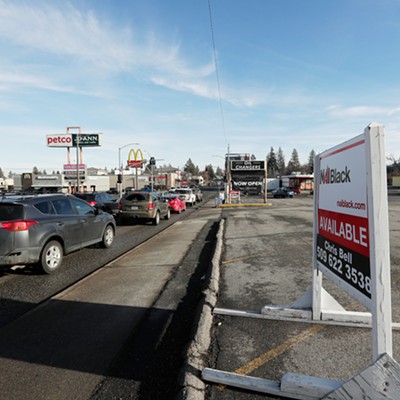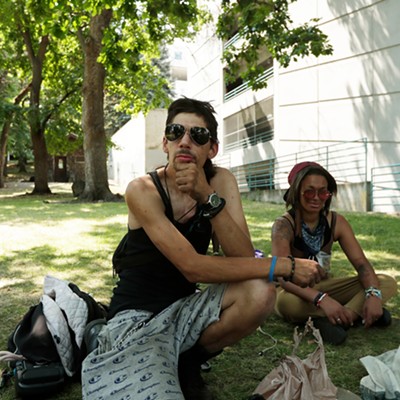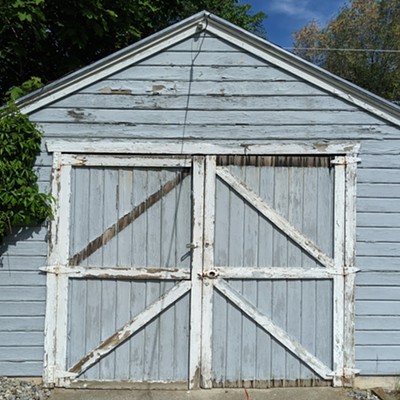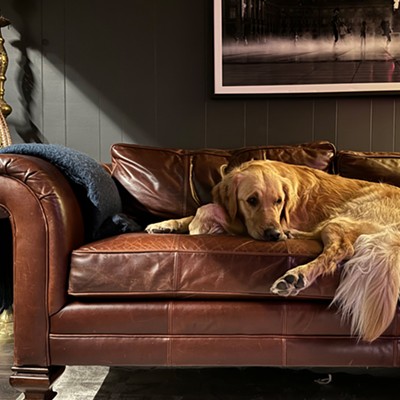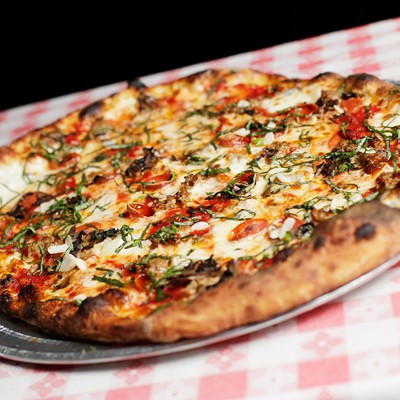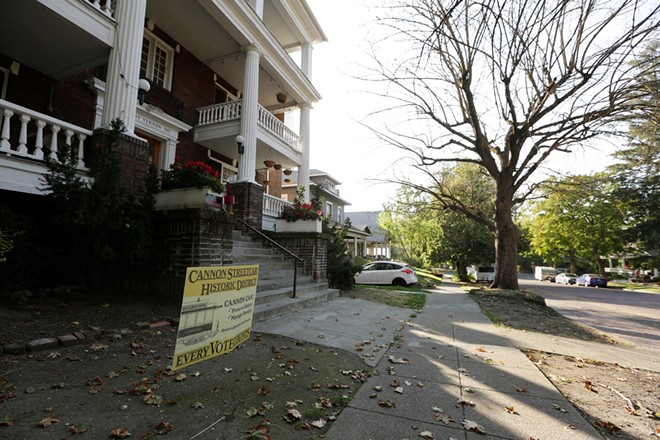
With its yellow trim and red brick columns, the Hans Moldenhauer House stands as a testament to the storied history of Spokane's historic Cliff/Cannon neighborhood.
Constructed in 1918, the home derives its name from one of its more remarkable owners, German musicologist Hans Moldenhauer.
Moldenhauer moved to Spokane in 1939 after fleeing Nazi Germany. Here, he founded the Spokane Conservatory and pursued his passions of collecting, performing, and composing music. At the time of his death in 1987, Moldenhauer had amassed thousands of fragments of music history, including the manuscripts of Brahms, Beethoven and other prominent composers. These documents are currently displayed around the globe, including at Harvard University and the Library of Congress.
Today, partners Ian White and Dustin Hall own the home, and are adding pages to its story.
"Living here has really cemented how owners of older homes and older properties aren't really owners," White says, but are closer to "stewards of them through time."
Fueled by this sentiment, White and Hall joined a grassroots effort earlier this year to register the neighborhood as a Spokane Historic District, which would aid in maintaining the neighborhood's aesthetic and grant historic property owners tax incentives to relieve costs of home restoration.
Though parts of the neighborhood are registered as National Historic Districts, including the Marycliff-Cliff Park area and Ninth Avenue, that designation is more honorary and doesn't confer the same benefits that a local registry does.
The effort to preserve the neighborhood began in 2016, but just as the campaign was gaining momentum, COVID "blew the world up," White says. After being put on ice for two-and-a-half years, the work to make the proposed Cannon Streetcar Suburb Historic District a reality is heating back up.
WHEN STREETCARS RULED
As its lack of garages testifies, this neighborhood was built by streetcars.
From 1890 to 1936, streetcars conveyed residents up the precipitous incline of what was called Cannon Hill — a hill steep enough to keep residents to the flatter areas of the city before the advent of the streetcar, like Browne's Addition and downtown.
First there was a doomed cable car that trudged up the face of Monroe Street, which made the climb from 1890 to 1894, when its cable succumbed to the frigid winters. While Browne's boomed with homes — nearly 100 before the turn of the century — the lower South Hill only had about 20.
Then the electric Cannon Hill line was laid, and in the first 10 years of the new century 264 homes were built in the neighborhood. Many of the grandest homes were built facing the streetcar line, this a time when transit was embraced. To this day, Spokane Transit Authority buses follow some of these historic streetcar routes, passing by those original, historic homes that still stand today.
On Sept. 15, ballots were mailed to these homes and more. In all, about 500 households within this new historic boundary will get a chance to vote before Nov. 11. This narrow timeframe has mounted pressure on the Cliff/Cannon Neighborhood Council to intensify campaigning efforts, especially because the historical designation needs 50 percent of property owners to vote yes for the district to get protection. Failing to return a ballot counts as a no vote.
SAVING HISTORY
April and Baran Thompson bought their home in 2014 and have since renovated it into a multi-unit apartment complex that maintains the building's historical features.
The work wasn't without its troubles.
"We bought it, and it was scary," says April. "It was not maintained. There was a lot of deferred maintenance on everything."
The couple worked to get the house up to code, an arduous and expensive task that involved removing lead-based paint and installing missing siding.
In 2018, a fire devastated the building. No one was injured, but the house was entirely gutted, throwing away years of the Thompsons' hard work.
Thankfully, the couple kept fastidious records and photographed the home every time renovations were made.
But the work came at a significant cost for the couple. In permits alone, the Thompsons paid close to $30,000, which doesn't include costs they paid to update electricity, fire alarms, sprinkler systems and "everything that would go into commercial, multifamily housing."
If they had done the work in a district like the one proposed, much of their spending could've been partly recouped through various incentives provided by the city.
Under the proposed district, the Spokane Historic Landmarks Commission or the historic preservation officer will quickly examine facade changes like a new roof, windows or siding. Exterior painting wouldn't be subject to review, nor would interior renovations.
Spokane Historic Preservation Officer Megan Duvall says design review is not focused on one sole building, but rather is community focused.
"Yes, we may be reviewing your property, but we're also looking at the house across the street," she says.
On its paperwork nominating the district for historic protection, the rules of design review are detailed, saying that it aims to guide property owners to "make design decisions that reinforce, rather than diminish, the vibrant and varied character of the neighborhood."
Money spent on any renovation, inside or out, counts toward a tax incentive program. Homeowners who spend 25 percent of their home's value in a two-year period are eligible for a decadelong property tax discount.
It's the promise of fueling rehabilitation that won the Thompsons' support for the district, but there's more.
"By saying yes, you're saying yes to preserving a lost form of art, the craftsmanship, the architecture and the history of the people who are here," April says.
NIMBY?
As the housing affordability crisis continues across the nation, preservation efforts have been accused of hampering efforts to build more housing. From Los Angeles to Seattle, projects to build multi-unit buildings have been blocked by neighbors invoking historic preservation.
White, who owns the Moldenhauer House, says the effort is not anti-development and in fact can increase the neighborhood's amount of affordable housing while protecting its architectural and historic legacy. He rejects the idea that he is stopping something from happening in his neighborhood that he would support elsewhere.
"We're not NIMBYs," White says (referring to the shorthand for Not In My BackYard). "I think our neighborhood can increase its density, but this effort really seeks to do that in a way that can support and enhance density while maintaining a sense of place and what makes an area special."
Duvall, with the city, says preserving historic homes ensures that affordable housing remains in Spokane. In this neighborhood, at least, she's right: Diminutive bungalows and apartment buildings are as common as larger single-family homes. The first duplex was built in the neighborhood almost 120 years ago, when it was one of the only areas Black and Jewish Spokanites could buy homes.
"I am hopeful that the recent changes to the MFTE (Multi-Family Tax Exemption) program will encourage more developers to add affordable units to their projects – allowing for more density and affordability within historic districts," says Duvall in an email. "Historic Preservation's role in those projects is to make sure that they fit into the neighborhood and are an enhancement rather than a detraction."
White and Hall remain optimistic that homeowners will vote in favor of the historical designation, and aim to dispel any misconceptions community members may have about its implications, the most common of which is discomfort with being told what they can and cannot do with their homes.
Hall responds to these concerns by telling them that design review "allows people to still have flexibility to style their house as they want."
Hall and White say they plan to go door to door to educate their neighbors and to phone property investors to make them aware of the effort and encourage them to vote. Between now and Nov. 11, increasing yes votes remains the primary goal.
"We both love Spokane, and we love this neighborhood," White says. "We really want to preserve this neighborhood as something truly special." ♦




